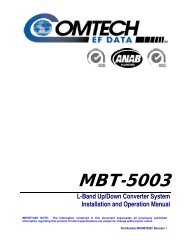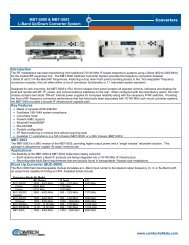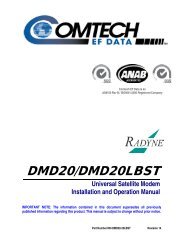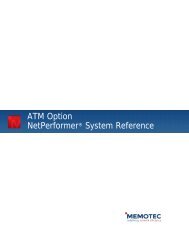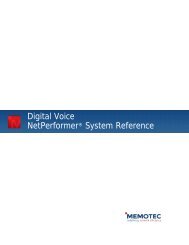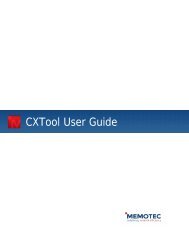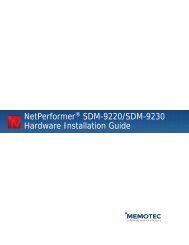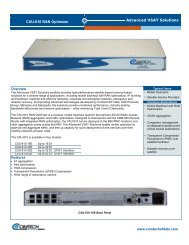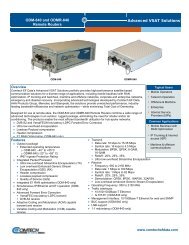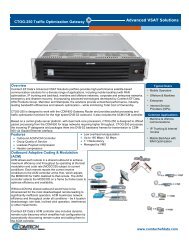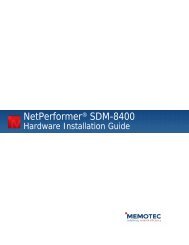Quality of Service - Comtech EF Data
Quality of Service - Comtech EF Data
Quality of Service - Comtech EF Data
You also want an ePaper? Increase the reach of your titles
YUMPU automatically turns print PDFs into web optimized ePapers that Google loves.
<strong>Quality</strong> <strong>of</strong> <strong>Service</strong> (QoS)<br />
NetPerformer ® System Reference
COPYRIGHTS AND DISCLAIMERS<br />
Published Date: April 2011<br />
Document # 1606<br />
This publication contains information proprietary and confidential to Memotec Inc. Any reproduction,<br />
disclosure or unauthorized use <strong>of</strong> this publication is expressly prohibited except as Memotec Inc. may<br />
otherwise authorize in writing.<br />
Memotec Inc. reserves the right to make changes without notice in product or component design as warranted<br />
by evolution in user needs or progress in engineering or manufacturing technology. Changes which affect the<br />
operation <strong>of</strong> the unit will be documented in the next revision <strong>of</strong> the manual.<br />
We have made every effort to ensure the accuracy <strong>of</strong> the information presented in our documentation.<br />
However, Memotec assumes no responsibility for the accuracy <strong>of</strong> the information published. Product<br />
documentation is subject to change without notice. Changes, if any, will be incorporated in new editions <strong>of</strong><br />
these documents. Memotec may make improvements or changes in the products or programs described within<br />
the documents at any time without notice. Mention <strong>of</strong> products or services not manufactured or sold by<br />
Memotec is for informational purposes only and constitutes neither an endorsement nor a recommendation for<br />
such products or services.<br />
Memotec Inc. is a wholly owned subsidiary <strong>of</strong> <strong>Comtech</strong> <strong>EF</strong> <strong>Data</strong> Corp., and its parent company <strong>Comtech</strong><br />
Telecommunications Corp (NASDAQ: CMTL).<br />
AccessView, CXTool, CX-U Series, CX-UA Series, AbisXpress, NetPerformer, AccessGate, ACTView, SDM-<br />
8400, and the SDM-9000 series <strong>of</strong> products are either registered trademarks or trademarks <strong>of</strong> Memotec Inc.in<br />
Canada, the United States <strong>of</strong> America, and in other countries.<br />
Windows is a registered trademark <strong>of</strong> Micros<strong>of</strong>t Corporation in the United States and other countries.<br />
Any other trademarks are the property <strong>of</strong> their respective companies.<br />
Copyright © 2011 Memotec Inc.<br />
Memotec Inc.<br />
7755 Henri Bourassa Blvd. West<br />
Montreal, Quebec<br />
Canada H4S 1P7<br />
Tel.: (514) 738-4781<br />
FAX: (514) 738-4436<br />
www.memotec.com
Contents<br />
Chapter 1: NetPerformer QoS Architecture . . . . . . . . . . . . . . . . . . . . . . . . . . . . . . . . . . . . 1-1<br />
1. 1 QoS Support . . . . . . . . . . . . . . . . . . . . . . . . . . . . . . . . . . . . . . . . . . . . . . . 1-2<br />
1. 2 PowerCell Prioritization over IP . . . . . . . . . . . . . . . . . . . . . . . . . . . . . . . . . 1-3<br />
1. 3 QoS Standards on the NetPerformer. . . . . . . . . . . . . . . . . . . . . . . . . . . . . 1-4<br />
1. 4 Voice/Fax Prioritization . . . . . . . . . . . . . . . . . . . . . . . . . . . . . . . . . . . . . . . 1-5<br />
Chapter 2: Traffic Priority . . . . . . . . . . . . . . . . . . . . . . . . . . . . . . . . . . . . . . . . . . . . . . . . . . . 2-1<br />
2. 1 About Traffic Priority . . . . . . . . . . . . . . . . . . . . . . . . . . . . . . . . . . . . . . . . . 2-2<br />
2.1.1 Prioritization . . . . . . . . . . . . . . . . . . . . . . . . . . . . . . . . . . . . . . . . 2-2<br />
2. 2 Traffic Filtering . . . . . . . . . . . . . . . . . . . . . . . . . . . . . . . . . . . . . . . . . . . . . . 2-3<br />
2.2.1 Configuring the Traffic Filters . . . . . . . . . . . . . . . . . . . . . . . . . . . 2-3<br />
2.2.2 Filter Syntax . . . . . . . . . . . . . . . . . . . . . . . . . . . . . . . . . . . . . . . . 2-4<br />
2.2.3 Discarding Frames . . . . . . . . . . . . . . . . . . . . . . . . . . . . . . . . . . . 2-5<br />
2.2.4 How the Filters are Applied . . . . . . . . . . . . . . . . . . . . . . . . . . . . 2-5<br />
2. 3 Traffic Distribution and Bandwidth Allocation . . . . . . . . . . . . . . . . . . . . . . 2-7<br />
2.3.1 Configuring the Traffic Classes . . . . . . . . . . . . . . . . . . . . . . . . . 2-9<br />
2.3.2 Bandwidth Allocation Example. . . . . . . . . . . . . . . . . . . . . . . . . 2-10<br />
Chapter 3: DiffServ 802.1 p/q ToS . . . . . . . . . . . . . . . . . . . . . . . . . . . . . . . . . . . . . . . . . . . . 3-1<br />
3. 1 NetPerformer DiffServ Support . . . . . . . . . . . . . . . . . . . . . . . . . . . . . . . . . 3-2<br />
3. 2 Setting Up the DiffServ Values . . . . . . . . . . . . . . . . . . . . . . . . . . . . . . . . . 3-3<br />
3. 3 DiffServ Application Scenario . . . . . . . . . . . . . . . . . . . . . . . . . . . . . . . . . . 3-4<br />
3. 4 DiffServ Statistics Counters . . . . . . . . . . . . . . . . . . . . . . . . . . . . . . . . . . . . 3-5<br />
Chapter 4: Traffic Filters . . . . . . . . . . . . . . . . . . . . . . . . . . . . . . . . . . . . . . . . . . . . . . . . . . . . 4-1<br />
4. 1 SE/FILTER Configuration Parameters. . . . . . . . . . . . . . . . . . . . . . . . . . . . 4-2<br />
4. 2 APPLETALK . . . . . . . . . . . . . . . . . . . . . . . . . . . . . . . . . . . . . . . . . . . . . . . 4-3<br />
4. 3 DSAP . . . . . . . . . . . . . . . . . . . . . . . . . . . . . . . . . . . . . . . . . . . . . . . . . . . . . 4-3<br />
4. 4 ETHERTYPE . . . . . . . . . . . . . . . . . . . . . . . . . . . . . . . . . . . . . . . . . . . . . . . 4-3<br />
4. 5 FRP . . . . . . . . . . . . . . . . . . . . . . . . . . . . . . . . . . . . . . . . . . . . . . . . . . . . . . 4-4<br />
4. 6 FTP . . . . . . . . . . . . . . . . . . . . . . . . . . . . . . . . . . . . . . . . . . . . . . . . . . . . . . 4-4<br />
4. 7 IPDST . . . . . . . . . . . . . . . . . . . . . . . . . . . . . . . . . . . . . . . . . . . . . . . . . . . . 4-4<br />
Memotec Inc.
Memotec Inc.<br />
4. 8 IPQOS. . . . . . . . . . . . . . . . . . . . . . . . . . . . . . . . . . . . . . . . . . . . . . . . . . . . 4-5<br />
4. 9 IPSRC . . . . . . . . . . . . . . . . . . . . . . . . . . . . . . . . . . . . . . . . . . . . . . . . . . . . 4-5<br />
4. 10 IPX. . . . . . . . . . . . . . . . . . . . . . . . . . . . . . . . . . . . . . . . . . . . . . . . . . . . . . . 4-6<br />
4. 11 IPXSAP . . . . . . . . . . . . . . . . . . . . . . . . . . . . . . . . . . . . . . . . . . . . . . . . . . . 4-6<br />
4. 12 MACDST . . . . . . . . . . . . . . . . . . . . . . . . . . . . . . . . . . . . . . . . . . . . . . . . . . 4-6<br />
4. 13 MACQOS . . . . . . . . . . . . . . . . . . . . . . . . . . . . . . . . . . . . . . . . . . . . . . . . . 4-7<br />
4. 14 MACSRC. . . . . . . . . . . . . . . . . . . . . . . . . . . . . . . . . . . . . . . . . . . . . . . . . . 4-7<br />
4. 15 NETBIOS. . . . . . . . . . . . . . . . . . . . . . . . . . . . . . . . . . . . . . . . . . . . . . . . . . 4-8<br />
4. 16 SNA. . . . . . . . . . . . . . . . . . . . . . . . . . . . . . . . . . . . . . . . . . . . . . . . . . . . . . 4-8<br />
4. 17 SNAP. . . . . . . . . . . . . . . . . . . . . . . . . . . . . . . . . . . . . . . . . . . . . . . . . . . . . 4-8<br />
4. 18 SNMP . . . . . . . . . . . . . . . . . . . . . . . . . . . . . . . . . . . . . . . . . . . . . . . . . . . . 4-9<br />
4. 19 SSAP. . . . . . . . . . . . . . . . . . . . . . . . . . . . . . . . . . . . . . . . . . . . . . . . . . . . . 4-9<br />
4. 20 TCP . . . . . . . . . . . . . . . . . . . . . . . . . . . . . . . . . . . . . . . . . . . . . . . . . . . . . . 4-9<br />
4. 21 TELNET. . . . . . . . . . . . . . . . . . . . . . . . . . . . . . . . . . . . . . . . . . . . . . . . . . 4-10<br />
4. 22 TN3270 . . . . . . . . . . . . . . . . . . . . . . . . . . . . . . . . . . . . . . . . . . . . . . . . . . 4-10<br />
4. 23 UDP. . . . . . . . . . . . . . . . . . . . . . . . . . . . . . . . . . . . . . . . . . . . . . . . . . . . . 4-10<br />
4. 24 Combinations . . . . . . . . . . . . . . . . . . . . . . . . . . . . . . . . . . . . . . . . . . . . . 4-11<br />
Index . . . . . . . . . . . . . . . . . . . . . . . . . . . . . . . . . . . . . . . . . . . . . . . . . . . . . . . . . . . . . . . Index-1
NetPerformer QoS Architecture<br />
1<br />
Memotec Inc. 1-1
<strong>Quality</strong> <strong>of</strong> <strong>Service</strong><br />
1.1 QoS Support<br />
The NetPerformer supports 8 classes <strong>of</strong> service for prioritizing legacy types <strong>of</strong> serial<br />
traffic, such as SNA, as well as LAN bridging and IP/IPX routing. A priority weighting is<br />
assigned to each class <strong>of</strong> service. The NetPerformer QoS architecture allows traffic to be<br />
divided into a hierarchy <strong>of</strong> classes, each one with its own relative weight.<br />
• In case <strong>of</strong> congestion, each class is limited to a certain percentage <strong>of</strong> the available<br />
bandwidth<br />
• Borrowing bandwidth from under-utilized or idle classes is permitted.<br />
• All large data packets or frames are segmented into cells <strong>of</strong> 96 bytes maximum<br />
and the relative weight is measured on this basis.<br />
• The cell-based architecture <strong>of</strong> the NetPerformer (PowerCell) allows very fine<br />
granularity and prevents, for example, a large IP data frame <strong>of</strong> 1500 bytes being<br />
treated the same way as a 20 byte voice sample.<br />
NOTE: PowerCell is the trademarked term for the PVCR protocol (Programmable<br />
Variable Cell Relay).<br />
Many different traffic types may be active on the LAN (FTP, Telnet, UDP, etc.). The<br />
NetPerformer provides the ability to further prioritize this traffic according to protocol<br />
type, port number or address.<br />
While supporting standard QoS at both Layer 2 and 3, the NetPerformer also does<br />
mapping and conversion to provide end-to-end QoS, filling the gaps. With the advent <strong>of</strong><br />
VoIP and other real-time applications this is a particularly valuable feature.<br />
In addition to its use as an access device, the NetPerformer can provide switching at<br />
intermediate nodes.<br />
• A network designed with NetPerformer at all locations that uses PowerCell over<br />
all WAN links can maintain QoS even when going over multiple hops and<br />
through multiple nodes.<br />
• QoS is achieved independently <strong>of</strong> the network infrastructure used: switched or<br />
leased lines including ISDN, Frame Relay, satellite, wireless or ATM.<br />
• When using PowerCell over IP, prioritization within the IP tunnel is used to<br />
deliver the highest priority traffic to the network first (see next section).<br />
1-2 Memotec Inc.
1.2 PowerCell Prioritization over IP<br />
NetPerformer QoS Architecture<br />
PowerCell provides data compression, which significantly reduces the amount <strong>of</strong><br />
bandwidth required across the WAN. This is especially true for IP traffic, including VoIP.<br />
Latency and jitter are also reduced through more efficient use <strong>of</strong> bandwidth.<br />
PowerCell can also be encapsulated over IP to take advantage <strong>of</strong> cost effective IP-based<br />
carrier <strong>of</strong>ferings.<br />
• PowerCell not only provides the ability to prioritize all the traffic effectively, but<br />
can also regulate the flow <strong>of</strong> information over IP.<br />
• The rate <strong>of</strong> information transfer can be configured to match any potential bottleneck<br />
in the network, regulating the flow <strong>of</strong> information from all PowerCell users<br />
in the network.<br />
• The NetPerformer can also set the IP Precedence bits in order to take advantage<br />
<strong>of</strong> prioritization on the <strong>Service</strong> Provider network.<br />
• The user can define the relative weight <strong>of</strong> all classes, and benefit from the Power-<br />
Cell QoS architecture by mapping IP Precedence to the internal NetPerformer<br />
classes <strong>of</strong> service.<br />
PowerCell with<br />
predefined priority<br />
PowerCell end-to-end<br />
Prioritization is transparent<br />
Mapping <strong>of</strong> PowerCell to IP Precedence<br />
IP Precedence is used over the IP network<br />
Figure 1-1: PowerCell Prioritization over IP<br />
PowerCell with<br />
predefined priority<br />
PowerCell over IP<br />
Memotec Inc. 1-3
<strong>Quality</strong> <strong>of</strong> <strong>Service</strong><br />
1.3 QoS Standards on the NetPerformer<br />
Since IP is rapidly becoming the backbone protocol <strong>of</strong> choice, support <strong>of</strong> standards-based<br />
QoS is crucial to providing consistent levels <strong>of</strong> service across the network.<br />
The NetPerformer supports the following QoS standards:<br />
• IEEE 802.1p/q: Initially designed to support Virtual LAN (VLAN) interoperability,<br />
this standard was extended to support traffic priority.<br />
- The VLAN function was used to logically separate groups <strong>of</strong> users who share<br />
the same physical LAN segment. Refer to the Virtual LAN fascicle <strong>of</strong> this<br />
document series.<br />
- For VLAN traffic prioritization, the NetPerformer includes a special filter that<br />
adapts the 802.1p prioritization bits to PowerCell classes <strong>of</strong> service, allowing<br />
a relative priority weight to be used over the network.<br />
- When the remote destination does not use VLAN, the NetPerformer can be<br />
configured to map the Layer 2 prioritization bits to the Layer 3 IP Precedence<br />
(using the VLAN Priority Conversion parameter on the LAN port). This<br />
ensures that VLAN traffic is properly prioritized end-to-end over a fully<br />
routed network.<br />
• IETF Differentiated <strong>Service</strong>s, or DiffServ: A QoS mechanism related to IP<br />
Precedence, DiffServ <strong>of</strong>fers up to 64 service classes and overcomes some Type <strong>of</strong><br />
<strong>Service</strong> (ToS) limitations, especially when multiple networks are involved. See<br />
DiffServ 802.1 p/q ToS on page 1.<br />
1-4 Memotec Inc.
1.4 Voice/Fax Prioritization<br />
NetPerformer QoS Architecture<br />
Due to the delay-sensitive nature <strong>of</strong> voice and fax transmissions, it is essential that they be<br />
prioritized to avoid the generation <strong>of</strong> delays. All traffic entering a NetPerformer channel is<br />
automatically given high-priority status with respect to data from other sources. This<br />
ensures guaranteed bandwidth access in a shared network environment and an<br />
uninterrupted flow from source to destination.<br />
Through protocol sorting, the NetPerformer routing unit differentiates delay-sensitive<br />
cells from non-sensitive cells, and directs these cells to their corresponding transmit<br />
queues. The architecture <strong>of</strong> the NetPerformer receivers, combined with the differentiation<br />
<strong>of</strong> data upon entrance to the receivers, ensures accelerated processing <strong>of</strong> voice and fax<br />
without jeopardizing the processing <strong>of</strong> non-sensitive data.<br />
Each NetPerformer along the virtual path selects a virtual channel according to the priority<br />
class assigned to the virtual connection. In this way, the high priority <strong>of</strong> voice/fax traffic is<br />
maintained uniformly along the entire virtual path.<br />
Each NetPerformer routing unit monitors its transmit queue for the priority level <strong>of</strong> the<br />
cells that are received. When high-priority cells arrive, they are expedited to the next<br />
NetPerformer on the virtual path before processing the lower priority cells. Lower-priority<br />
cells are buffered until the higher-priority voice and fax cells are sent. This guarantees<br />
voice/fax prioritization throughout the network.<br />
Memotec Inc. 1-5
<strong>Quality</strong> <strong>of</strong> <strong>Service</strong><br />
1-6 Memotec Inc.
Traffic Priority<br />
2<br />
Memotec Inc. 2-1
<strong>Quality</strong> <strong>of</strong> <strong>Service</strong><br />
2.1 About Traffic Priority<br />
2.1.1 Prioritization<br />
An important aspect <strong>of</strong> the NetPerformer is its ability to prioritize mission-critical data.<br />
• Delay sensitive protocols such as LLC2, SDLC or any other legacy protocol can<br />
be assigned a high priority so that they reach their destination before other less<br />
critical data cells, eliminating response time problems and session timeouts.<br />
• In a shared network environment, mission critical applications can have guaranteed<br />
access to their part <strong>of</strong> the bandwidth.<br />
To ensure prioritization <strong>of</strong> mission-critical data, the partitioning <strong>of</strong> the bandwidth must be<br />
planned carefully.<br />
You can set the priority class separately for each traffic type or user destination<br />
(transparent port, PU, PVC or LAN traffic). Refer to Configuring the Traffic Classes on<br />
page 9.<br />
• Each priority class is assigned a weight value, which determines how bandwidth<br />
should be allocated in case <strong>of</strong> congestion.<br />
• The higher the weight, the greater the bandwidth portion used. The traffic in a<br />
high weight class will receive higher priority.<br />
• Once the priority class is set for a particular traffic type, it is maintained uniformly<br />
from one unit to the next along the entire virtual path. This guarantees<br />
protocol prioritization throughout the network.<br />
Traffic can also be prioritized with respect to other traffic types by taking advantage <strong>of</strong><br />
protocol sorting and filters.<br />
• You decide what priority class a particular traffic type should belong to, and set<br />
its priority by writing a filter that includes the name <strong>of</strong> the traffic type and its priority<br />
class.<br />
For example, TELNET>3 places any TELNET traffic in priority class 3.<br />
Filters are discussed further in the next section. Examples <strong>of</strong> all filter types are provided in<br />
the appendix Traffic Filters on page 1.<br />
2-2 Memotec Inc.
2.2 Traffic Filtering<br />
Traffic Priority<br />
The NetPerformer includes a filtering capability which can be used to prioritize a<br />
particular traffic type over the link or reduce broadcast traffic across the network. Each<br />
filter contains a set <strong>of</strong> criteria that:<br />
• Send specific frames over the composite link at a certain priority level<br />
• Prevent extraneous frames from being forwarded.<br />
This enables the NetPerformer to keep up with the traffic flow and permits prioritization<br />
<strong>of</strong> specific traffic types.<br />
An excessively large number <strong>of</strong> broadcast frames crossing the LAN segments can reduce<br />
the performance <strong>of</strong> remote bridge applications, where bandwidth is at a premium. For<br />
example, the use <strong>of</strong> all-routes, all-stations broadcasts for route determination under TCP/<br />
IP can place an unnecessary load on the composite links. If your network is large with<br />
multiple LANs, you should understand how broadcast techniques are used, and design<br />
filters (and your LAN topology) accordingly.<br />
2.2.1 Configuring the Traffic Filters<br />
The FILTER submenu <strong>of</strong> the SETUP command includes all parameters that are required to<br />
define a traffic filter.<br />
To configure a traffic filter:<br />
1. At the NetPerformer command line prompt, enter the menu sequence: SE � FILTER<br />
2. Select the FILTER number<br />
3. Enter the filter Definition. Refer to Filter Syntax on page 4, and the appendix Traffic<br />
Filters on page 1<br />
4. Set Active to YES.<br />
Setup (SE)<br />
Unit ID><br />
(main prompt)<br />
FILTER (FI)<br />
Figure 2-1: SETUP/FILTER Path in the CLI Tree<br />
Memotec Inc. 2-3
<strong>Quality</strong> <strong>of</strong> <strong>Service</strong><br />
SE/FILTER<br />
example:<br />
2.2.2 Filter Syntax<br />
SDM-9230>SE<br />
SETUP<br />
Item (BRIDGE/CALLER ID/CLASS/CUSTOM/FILTER/GLOBAL/GSM/HUNT/IP/IPX/<br />
MAP/<br />
PHONE/PORT/PU/PPPOE/PPPUSER/PVC/REDUNDANCY/SCHEDULE/SLOT/USER/<br />
VLAN,<br />
def:BRIDGE) ? FILTER<br />
FILTER number (1-32,def:1) ?<br />
FILTER 1> Definition (def:) ? TELNET>3<br />
FILTER 1> Active (def:NO) ? YES<br />
These filter parameters and their SNMP and configuration text equivalents are detailed in<br />
SE/FILTER Configuration Parameters on page 2.<br />
Filters can be written in two ways, depending on the traffic type:<br />
• The filter assigns a particular traffic type to a particular class (from 1 to 8).<br />
Example: FTP>4, which assigns all FTP traffic to class 4. The actual priority <strong>of</strong><br />
FTP traffic is determined by the way class 4 is defined, as explained in<br />
Configuring the Traffic Classes on page 9.<br />
- This simple method <strong>of</strong> writing a filter can be used for the following traffic<br />
types: APPLETALK, FRoIP, FTP, IPX, IPXSAP, NETBIOS, SNA, SNMP,<br />
TELNET<br />
- The traffic type name must precede the > symbol. Enter the name exactly as<br />
you see it listed in the appendix Traffic Filters on page 1.<br />
• The filter assigns a specific address, port or frame value to a particular class.<br />
Example: IPSRC(198.168.43.0,255.255.255.0)>3, which instructs the NetPerformer<br />
to mask the source IP address <strong>of</strong> all IP frames received, and compare<br />
them with address 198.168.43.0. If a match is found the frame is sent under the<br />
priority determined by class 3.<br />
- Examples <strong>of</strong> this method <strong>of</strong> writing a filter include those for the following<br />
traffic types: IP, MAC, TCP, UDP<br />
- IP and MAC filters specify the source or destination address as well as the<br />
mask. Each address received is masked and compared with the specified<br />
address. The filter syntax is:<br />
IPSRC(address,mask)>class or IPDST(address,mask)>class<br />
Example: IPDST(128.128.128.0,255.255.255.0)>3<br />
MACSRC(address)>class or MACDST(address)>class<br />
Example: MACSRC(002083XXXXXX)>3, which generates the source MAC<br />
address 002083000000 and the MAC mask FFFFFF000000.<br />
- TCP and UDP filters specify the minimum and maximum destination ports.<br />
All frames whose destinations lie within this range (including the minimum<br />
2-4 Memotec Inc.
2.2.3 Discarding Frames<br />
Traffic Priority<br />
and maximum ports themselves) are sent under the priority determined by the<br />
specified class. The filter syntax is:<br />
TCP(min_port,max_port)>class<br />
Example: TCP(2065,2067)>3<br />
UDP(min_port,max_port)>class<br />
Example: UDP(160,163)>3<br />
• Filters can also be combined with the logical operators ! (not), & (and) and | (or).<br />
For example, to assign a subset <strong>of</strong> IP and MAC data to class 3, you could write<br />
the filter:<br />
IPSRC(128.128.128.0,255.255.255.0)|MACDST(123456789ABC)>3<br />
NOTE: Examples <strong>of</strong> all filter types are given in the appendix Traffic Filters on page 1.<br />
See also Configuring the Traffic Filters on page 3.<br />
You can also use the filters to discard frames. To do this:<br />
• Enter X instead <strong>of</strong> the class number after the > symbol in the filter definition.<br />
2.2.4 How the Filters are Applied<br />
Example: FTP>X, which instructs the NetPerformer to discard all FTP traffic.<br />
Use this notation whenever possible to reduce broadcast traffic across the<br />
network.<br />
NOTE: FTP and TELNET traffic can also be restricted to a list <strong>of</strong> authorized IP<br />
addresses. For details, refer to the chapter Controlling Access to the Net-<br />
Performer in the Quick Configuration.<br />
Default Order <strong>of</strong> Application<br />
The NetPerformer supports a maximum <strong>of</strong> 32 filters, numbered from 1 to 32. When more<br />
than one filter is defined:<br />
• The NetPerformer applies all configured filters to each frame, starting with the<br />
lowest numbered filter.<br />
This is the order the filters are applied on power up or reset. If you add a new filter<br />
during a session, it will be applied after the other filters, even if it is a lower<br />
numbered filter.<br />
Memotec Inc. 2-5
<strong>Quality</strong> <strong>of</strong> <strong>Service</strong><br />
• When a match is found, the NetPerformer performs the action specified by the<br />
class number (or X), and then analyzes the next frame.<br />
Since the filters are applied in order, you should define the filters that affect a<br />
large number <strong>of</strong> frames before the filters that affect fewer frames, to minimize the<br />
number <strong>of</strong> filters the NetPerformer has to examine.<br />
Example:<br />
• If your network has mostly MAC traffic, use Filter 1 to define the MAC filter.<br />
This way, a higher amount <strong>of</strong> frames will be handled by the first filter.<br />
• If you also have SNMP and UDP traffic, use Filter 2 for SNMP and Filter 3 for<br />
UDP. This will avoid sending the SNMP traffic under the priority class intended<br />
for UDP, since SNMP runs under UDP.<br />
• If you want to discard specific IP frames, use a higher numbered filter. The Net-<br />
Performer will have to examine this filter only if the frame does not match any <strong>of</strong><br />
the lower numbered filters.<br />
Fine-tuning the Application<br />
By default, all filters are applied to all connections on the NetPerformer unit in the order<br />
described in the preceding section. WAN traffic filters, however, can be fine tuned on an<br />
individual connection (port or PVC) using the Filter parameter. Each port or PVC can be<br />
configured with a different filter application scenario.<br />
NOTE: This includes traffic going over the FireWire links <strong>of</strong> an SDM-9500 chassis.<br />
• Enter ALL to apply all traffic filters that were defined with the SETUP/FILTER<br />
command. This is the default value for all WAN connections and FireWire links.<br />
Use the DP/FILTER console command to view the current list <strong>of</strong> filters.<br />
• Enter NONE to disable filtering on an individual WAN connection.<br />
• Enter a specific filter number (from 1 to 32) or a set <strong>of</strong> filter numbers to select a<br />
subset <strong>of</strong> the filters that have been defined for this NetPerformer unit.<br />
When selecting more than one filter, separate each filter number with commas:<br />
PORT 1> Filter (def:ALL) ? 2,21,10<br />
The filters you select are applied to the traffic that passes over this WAN connection<br />
in the order you specify for this parameter. In the above example, Filter 21<br />
would be applied before Filter 10.<br />
NOTE: WAN configuration details are provided in the WAN/Leased Lines and<br />
WAN/Frame Relay fascicles <strong>of</strong> this document series.<br />
2-6 Memotec Inc.
Traffic Priority<br />
2.3 Traffic Distribution and Bandwidth Allocation<br />
Traffic enters the NetPerformer from several sources and, depending on how the ports are<br />
used, the output travelling over the link can be sorted into several classes.<br />
As mentioned on page 2, the link can accommodate 8 possible classes, each with its own<br />
user-defined relative weight. This determines how much <strong>of</strong> the available bandwidth each<br />
class can use.<br />
Due to the multiple demands made on the bandwidth, the portion <strong>of</strong> the bandwidth<br />
allocated to each class must be carefully determined in terms <strong>of</strong> its relative weight. The<br />
weight determines how many cells or packets are allowed to be transmitted for a particular<br />
class versus the other classes within a given period <strong>of</strong> time.<br />
Each user port, PU, PVC and LAN connection is assigned to a particular class by default.<br />
You can change both the class assignment and its weight for any individual connection.<br />
Refer to Configuring the Traffic Classes on page 9.<br />
Example:<br />
Figure 2-2: Classes Sharing the Bandwidth<br />
Type <strong>of</strong> Connection<br />
Default<br />
Class<br />
LAN (IP routing, bridge) 1 1<br />
PU (LINKS mode) 2 1<br />
PVC (Frame Relay or ATM) 3 1<br />
User port (HDLC, PASSTHRU, T-ASYNC, R-ASYNC,<br />
BSC, COP, DDCMP protocol)<br />
3 1<br />
Table 2-1: Default class and weight <strong>of</strong> NetPerformer connections<br />
Default<br />
Weight<br />
• You could configure class 1 with weight 2 for 50% <strong>of</strong> the bandwidth, and leave<br />
classes 2 and 3 at the default weight 1 for 25% <strong>of</strong> the bandwidth each.<br />
Memotec Inc. 2-7
<strong>Quality</strong> <strong>of</strong> <strong>Service</strong><br />
• In this way, all user destinations that are set to priority class 1 are guaranteed<br />
50% <strong>of</strong> the bandwidth, regardless <strong>of</strong> the frame size used or the number <strong>of</strong> frames<br />
generated.<br />
• If you did not change the default class assignments, this would mean that all<br />
LAN traffic would receive higher priority than the other traffic types.<br />
NOTE: If you leave the weight at its default value <strong>of</strong> 1 for all classes, the NetPerformer<br />
will not differentiate between traffic types. That is, all traffic types<br />
defined on your network will receive an equal portion <strong>of</strong> the bandwidth. To<br />
prioritize data you must increase the weight <strong>of</strong> the class to which the data<br />
type belongs.<br />
The class assignments can be supplemented by filters, which make specific correlations<br />
between data types and priority classes.<br />
• This can be used to effectively handle data that may not originate from the direct<br />
NetPerformer connection.<br />
For example, bridged SNA traffic will be assigned to class 1 by default unless<br />
you define the filter SNA>2.<br />
• Filters can also be used to handle exceptions to how the classes are assigned for a<br />
particular data type, as is <strong>of</strong>ten required for IP routing.<br />
For details on writing filters, see Configuring the Traffic Filters on page 3 and Filter<br />
Syntax on page 4.<br />
2-8 Memotec Inc.
2.3.1 Configuring the Traffic Classes<br />
SE/CLASS<br />
example: with<br />
integer CLASS<br />
number<br />
Traffic Priority<br />
The CLASS submenu <strong>of</strong> the SETUP command includes all parameters that are required to<br />
define all traffic classes, and to select which traffic class shall be used as the default class<br />
for traffic types that have not been configured with a specific class.<br />
CLASS (CL)<br />
To configure a traffic class:<br />
Setup (SE)<br />
1. At the NetPerformer command line prompt, enter the menu sequence: SE � CLASS<br />
2. Select an integer value for the CLASS number<br />
Unit ID><br />
(main prompt)<br />
Figure 2-3: SETUP/CLASS Path in the CLI Tree<br />
3. Enter the relative bandwidth Weight that can be used by this class on the WAN link<br />
(SNMP equivalent: classWeight). Refer to Bandwidth Allocation Example on<br />
page 10<br />
The higher the weight, the greater the amount <strong>of</strong> bandwidth that will be allocated to<br />
traffic in this class. Thus the class with the highest relative weight will have the<br />
highest priority, which can be used to guarantee the response time for missioncritical<br />
traffic.<br />
4. Define the Preferred route with the Unit name <strong>of</strong> a remote NetPerformer unit (SNMP<br />
equivalent: classPrefRoute).<br />
When multiple WAN links are required to reach the traffic destination, this unit will<br />
be used as the next hop for this class <strong>of</strong> traffic if:<br />
- More than one route is available, and<br />
- All available routes are equal in cost.<br />
Tip: Assigning a different Preferred route to different classes helps ensure static<br />
load balancing <strong>of</strong> transparent traffic over all routes.<br />
SDM-9230>SE<br />
SETUP<br />
Item (BRIDGE/CALLER ID/CLASS/CUSTOM/FILTER/GLOBAL/GSM/HUNT/IP/IPX/<br />
Memotec Inc. 2-9
<strong>Quality</strong> <strong>of</strong> <strong>Service</strong><br />
SE/CLASS<br />
example: with<br />
default CLASS<br />
MAP/<br />
PHONE/PORT/PU/PPPOE/PPPUSER/PVC/REDUNDANCY/SCHEDULE/SLOT/USER/<br />
VLAN,<br />
def:BRIDGE) ? CLASS<br />
CLASS number (D<strong>EF</strong>AULT/1/2/3/4/5/6/7/8,def:1) ?<br />
CLASS 1> Weight (1-16,def:1) ? 2<br />
CLASS 1> Preferred route (def:) ? CHICAG0-9230<br />
The default traffic class represents the class number used for all LAN traffic that is not<br />
redirected to a specific traffic class using filters.<br />
To select the default traffic class:<br />
1. At the NetPerformer command line prompt, enter the menu sequence: SE � CLASS<br />
2. Enter D<strong>EF</strong>AULT as the CLASS number<br />
3. Select the Default class.<br />
2.3.2 Bandwidth Allocation Example<br />
SDM-9230>SE<br />
SETUP<br />
Item (BRIDGE/CALLER ID/CLASS/CUSTOM/FILTER/GLOBAL/GSM/HUNT/IP/IPX/<br />
MAP/<br />
PHONE/PORT/PU/PPPOE/PPPUSER/PVC/REDUNDANCY/SCHEDULE/SLOT/USER/<br />
VLAN,<br />
def:BRIDGE) ? CLASS<br />
CLASS number (D<strong>EF</strong>AULT/1/2/3/4/5/6/7/8,def:1) ? D<strong>EF</strong>AULT<br />
CLASS> Default class (0-8,def:1) ?<br />
The following scenario is for a network that uses IP routing and handles both SNA and<br />
BSC data. The same procedure can be used for any network that interconnects devices<br />
with different traffic types.<br />
To allocate the available bandwidth:<br />
1. Draw a table with your Traffic Type list under one column, and add columns for the<br />
Class, Weight and Bandwidth. Enter the default weight (always 1) and class for<br />
each traffic type, referring to Table 2-1. Leave the Bandwidth column empty for<br />
now.<br />
Traffic Type Class Weight Bandwidth<br />
SNA 2 1 __ %<br />
IP 1 1 __ %<br />
BSC 3 1 __ %<br />
Table 2-2: Example <strong>of</strong> Bandwidth Allocation characteristics (part 1)<br />
2. Decide which traffic type requires the highest priority. Raise its weight to 2.<br />
2-10 Memotec Inc.
Traffic Priority<br />
If more than two levels <strong>of</strong> priority are required, raise the weight <strong>of</strong> the highest<br />
priority traffic to 3 and the weight <strong>of</strong> the medium priority traffic to 2.<br />
Traffic Type Class Weight Bandwidth<br />
SNA 2 2 __ %<br />
IP 1 3 __ %<br />
BSC 3 1 __ %<br />
Table 2-3: Example <strong>of</strong> Bandwidth Allocation characteristics (part 2)<br />
3. Add up all values in the Weight column. Fill in the Bandwidth column for each<br />
traffic type by calculating the percentage <strong>of</strong> the weight divided by the total weight:<br />
Weight<br />
d�Bandwidth<br />
--------------------------------<br />
�<br />
=<br />
� 100�<br />
TotalWeight �<br />
Traffic Type Class Weight Bandwidth<br />
SNA 2 2 33%<br />
IP Routing 1 3 50%<br />
BSC 3 1 17%<br />
Table 2-4: Example <strong>of</strong> Bandwidth Allocation characteristics (part 3)<br />
4. Verify that the proposed bandwidth usage for each traffic type matches the needs <strong>of</strong><br />
your network. If it does not, adjust the weight values accordingly.<br />
5. Configure the classes using the SETUP/CLASS menu, as described in Configuring<br />
the Traffic Classes on page 9. For each class you require, specify its weight.<br />
6. If you want to configure an individual port, PU or PVC as belonging to a different<br />
class than the default class, adjust the Class parameter for that port, PU or PVC.<br />
7. Add any filters you may need, using the SETUP/FILTER menu, described in<br />
Configuring the Traffic Filters on page 3.<br />
In this example, the filter SNA>2 will ensure that bridged SNA data is given the same<br />
priority treatment as data from the PUs in spo<strong>of</strong>ing mode. With this filter the bridged SNA<br />
data will be sent under class 2, rather than the default LAN traffic class 1.<br />
Memotec Inc. 2-11
<strong>Quality</strong> <strong>of</strong> <strong>Service</strong><br />
2-12 Memotec Inc.
DiffServ 802.1 p/q ToS<br />
3<br />
Memotec Inc. 3-1
<strong>Quality</strong> <strong>of</strong> <strong>Service</strong><br />
3.1 NetPerformer DiffServ Support<br />
Another QoS capability <strong>of</strong> the NetPerformer is its support <strong>of</strong> IETF Differentiated <strong>Service</strong>s,<br />
or DiffServ. This feature allows specific protocols with low-latency or high-bandwidth<br />
demands to be routed more efficiently than other protocols. In particular, DiffServ allows<br />
prioritization <strong>of</strong> IP frames received from user devices such as IP phones.<br />
NOTE: The NetPerformer is also capable <strong>of</strong> setting the IP Precedence bits when<br />
transmitting PowerCell over IP, to preserve the prioritization scheme over IPbased<br />
backbones. See QoS Standards on the NetPerformer on page 4.<br />
DiffServ is an extension <strong>of</strong> prioritization models that use IP precedence, where the Type <strong>of</strong><br />
<strong>Service</strong> (ToS) field in the IP header is used to assign a particular level <strong>of</strong> privilege to the<br />
packet. In the case <strong>of</strong> DiffServ, six bits <strong>of</strong> the ToS field are used (rather than only three in<br />
the IP precedence model), providing greater flexibility in managing traffic prioritization.<br />
Prior to version 9.2.0, the NetPerformer was able to prioritize internal traffic (that is,<br />
internally generated voice packets) as well as external traffic received using a known<br />
protocol, for example, Telnet. With DiffServ, the NetPerformer can also support standard<br />
prioritization schemes coming from a connected IP-based device. Furthermore, the<br />
priority level assigned to each class <strong>of</strong> traffic is customizable, using the IPQOS filter.<br />
• The IPQOS filter maps the 6-bit differentiated service (DS) field in the IP header<br />
to the NetPerformer’s 8 classes <strong>of</strong> service plus the HIGH priority setting, which is<br />
usually used for voice.<br />
• This mapping provides a total <strong>of</strong> 32 filter definitions, providing a good level <strong>of</strong><br />
flexibility in various applications.<br />
• The DS field can be set according to the priority given to a specific kind <strong>of</strong> traffic<br />
or protocol. This allows the network to process those packets more efficiently,<br />
and accommodate any real-time high bandwidth requirements this traffic may<br />
have.<br />
3-2 Memotec Inc.
3.2 Setting Up the DiffServ Values<br />
SE/FILTER<br />
example: for<br />
DiffServ<br />
DiffServ 802.1 p/q ToS<br />
On the NetPerformer, DiffServ is implemented using the already existing FILTER<br />
submenu <strong>of</strong> the SETUP (SE) command. A new filter, IPQOS, can be defined to<br />
differentiate between packets containing different values in their DS fields. These values<br />
are mapped to a configured traffic priority class, which the NetPerformer uses internally to<br />
prioritize the packets.<br />
The IPQOS filter itself consists <strong>of</strong> a range <strong>of</strong> DS field values, assigned to a priority level<br />
from 1 to 8. A HIGH priority level can also be configured, which is typically used for voice<br />
applications running on the NetPerformer.<br />
To define the IPQOS filter on the NetPerformer unit using the console:<br />
• Enter the menu sequence: SE � FILTER.<br />
• Select the FILTER number.<br />
• Set Active to YES to activate this filter.<br />
• Enter the IPQOS filter definition at the Definition prompt.<br />
• The Definition must have the following syntax:<br />
IPQOS(min_value_<strong>of</strong>_range,max_value_<strong>of</strong>_range)>class_<strong>of</strong>_service<br />
where:min_value_<strong>of</strong>_range is a 6-bit binary value representing the lowest DS<br />
field value<br />
max_value_<strong>of</strong>_range is a 6-bit binary value representing the highest DS field<br />
value<br />
class_<strong>of</strong>_service represents the NetPerformer class <strong>of</strong> service, and ranges from 1<br />
to 8 plus the HIGH priority level usually used for voice.<br />
NOTE: If two IPQOS filters are defined with an overlapping range <strong>of</strong> values, the<br />
overlapped portion is assigned to the filter with the lowest FILTER number (1<br />
to 32).<br />
CHICAGO>SE<br />
SETUP<br />
Item (BRIDGE/CALLER ID/CLASS/CUSTOM/FILTER/GLOBAL/HUNT/IP/IPX/MAP/<br />
PHONE/<br />
PORT/PU/PPPOE/PPPUSER/PVC/REDUNDANCY/SCHEDULE/SLOT/USER/VLAN,<br />
def:BRIDGE) ? FILTER<br />
FILTER number (1-32,def:1) ?<br />
FILTER #1> Active (def:NO) ? YES<br />
FILTER #1> Definition (def:) ? IPQOS(000000,010111)>3<br />
To define the IPQOS filter on the NetPerformer unit via SNMP, use the equivalent SNMP<br />
variables: filterEntry, filterActive and filterDefinition. The filterDefinition requires the<br />
same syntax as for the console Definition parameter.<br />
Memotec Inc. 3-3
<strong>Quality</strong> <strong>of</strong> <strong>Service</strong><br />
3.3 DiffServ Application Scenario<br />
SE/FILTER<br />
example: for<br />
DiffServ voice<br />
prioritization<br />
The most common DiffServ application is the prioritization <strong>of</strong> voice packets over data<br />
packets. Since voice applications have a very low latency requirement, these packets must<br />
be given greater priority than other packets to ensure the quality <strong>of</strong> the output.<br />
Figure 3-1: DiffServ Application<br />
In this example, a Frame Relay link is used to transmit voice and data between one<br />
NetPerformer unit in New York and another in Denver.<br />
• An IP PBX is connected to each NetPerformer via a local Ethernet LAN.<br />
• A LAN connection at each site carries data traffic between workstations in Denver<br />
and the server in New York<br />
• Each IP PBX uses voice packets containing a DS field set to high priority<br />
(111011)<br />
• Both NetPerformer units have been configured with an IPQOS filter that assigns<br />
all voice packets carrying this DS field value to HIGH priority:<br />
• The two applications (voice and data) coexist harmoniously on the same link,<br />
with priority always being given to the voice application. <strong>Data</strong> traffic is routed<br />
with a relatively larger latency.<br />
CHICAGO>SE<br />
SETUP<br />
Item (BRIDGE/CALLER ID/CLASS/CUSTOM/FILTER/GLOBAL/HUNT/IP/IPX/MAP/<br />
PHONE/<br />
PORT/PU/PPPOE/PPPUSER/PVC/REDUNDANCY/SCHEDULE/SLOT/USER/VLAN,<br />
def:BRIDGE) ? FILTER<br />
FILTER number (1-32,def:1) ? 1<br />
FILTER #1> Definition (def:) ? IPQOS(111011,111011)>HIGH<br />
FILTER #1> Active (def:NO) ? YES<br />
3-4 Memotec Inc.
3.4 DiffServ Statistics Counters<br />
DC/QOS<br />
example<br />
DiffServ 802.1 p/q ToS<br />
New statistics counters have been added to the NetPerformer console to provide<br />
information on how much traffic has been routed at each priority level. These counters are<br />
grouped under the Item named QOS.<br />
To display the QOS counters:<br />
• Enter DC at the NetPerformer console command prompt.<br />
• Enter QOS at the Item prompt.<br />
CHICAGO>DC<br />
DISPLAY COUNTERS<br />
Item (CONFIG/PORT/PVC/IP/BOOTP/TIMEP/SLOT/Q922/Q933/NAT/SVC/QOS,<br />
def:CONFIG) ? QOS<br />
Priority Level 1<br />
Routed frames.....................................987<br />
Routed bytes...................................654235<br />
Priority Level 2<br />
.<br />
.<br />
.<br />
Priority Level 8<br />
Routed frames.....................................456<br />
Routed bytes...................................245545<br />
Priority Level High<br />
Routed frames.....................................786<br />
Routed bytes...................................495434<br />
Memotec Inc. 3-5
<strong>Quality</strong> <strong>of</strong> <strong>Service</strong><br />
3-6 Memotec Inc.
Traffic Filters<br />
4<br />
Memotec Inc. 4-1
<strong>Quality</strong> <strong>of</strong> <strong>Service</strong><br />
4.1 SE/FILTER Configuration Parameters<br />
FILTER number<br />
Table 4-1: Filter number parameters<br />
The filter entry that you want to define.<br />
Definition<br />
Table 4-2: Definition parameters<br />
The filter definition. The required syntax depends on the traffic type being filtered. Refer<br />
to the list <strong>of</strong> filters on the following pages.<br />
Active<br />
Console SNMP Text-based Config<br />
FILTER number filterIndex [filter#]<br />
Values: range is from 1 to the number <strong>of</strong> filters present on the system<br />
Default: 1<br />
Console SNMP Text-based Config<br />
Definition filterDefinition [filter#] Definition<br />
Values: Maximum <strong>of</strong> 128 alphanumeric characters<br />
Default: undefined<br />
Console SNMP Text-based Config<br />
Active filterActive [filter#] Active<br />
Table 4-3: Active parameters<br />
Enables (YES) or disables (NO) the filter.<br />
Values: NO, YES<br />
Default: NO<br />
The following is an alphabetical list <strong>of</strong> the filters that are currently supported by the<br />
Memotec NetPerformer, including a brief explanation and example <strong>of</strong> each. At the end <strong>of</strong><br />
this list is an example <strong>of</strong> how filters can be combined using logical operators (see<br />
“Combinations” on page 4-11).<br />
4-2 Memotec Inc.
4.2 APPLETALK<br />
4.3 DSAP<br />
4.4 ETHERTYPE<br />
Permits filtering Appletalk frames defined by:<br />
• SNAP = 00000080F3<br />
• SNAP = 080007809B<br />
• Ethertype = 809B<br />
Traffic Filters<br />
Syntax: APPLETALK>n<br />
• If 1 � n � 8, all Appletalk frames are transmitted under class n.<br />
• If n = X, all Appletalk frames are discarded.<br />
Example: To assign Appletalk data to class 3, use the filter: APPLETALK>3.<br />
Permits filtering frames that have a DSAP (Token-Ring and Ethernet 802.3 only).<br />
Syntax: DSAP(HH)>n<br />
• HH is a hexadecimal value indicating the frame type. For example, HH = 04 for<br />
SNA, E0 for IPX, F0 for NetBIOS, and so on.<br />
• If 1 � n � 8, all frames with the specified DSAP are transmitted under class n.<br />
• If n = X, all specified frames are discarded.<br />
Example: To remove all NetBIOS frames, use the filter: DSAP(F0)>X.<br />
Permits filtering frames with Ethertype (valid for Ethernet frames only).<br />
Syntax: ETHERTYPE(HHHH)>n<br />
• HHHH represents the Ethernet hexadecimal frame type. For example, HHHH =<br />
0800 for IP frames, 0806 for ARP frames, 809B for Appletalk frames, and so on.<br />
• If 1 � n � 8, all specified Ethernet frames are transmitted under class n.<br />
• If n = X, all specified frames are discarded.<br />
Example: To remove all IPX frames from Ethernet transmissions, use the filter:<br />
ETHERTYPE(8137)>X.<br />
Memotec Inc. 4-3
<strong>Quality</strong> <strong>of</strong> <strong>Service</strong><br />
4.5 FRP<br />
4.6 FTP<br />
4.7 IPDST<br />
Permits filtering all Frame Relay over IP packets.<br />
Syntax: FRP>n<br />
• If 1 � n � 8, all FRP frames are transmitted under class n.<br />
• If n = X, all FRP frames are discarded.<br />
Example: To prioritize Frame Relay traffic, use the filter: FTP>1.<br />
Permits filtering frames that carry the FTP protocol. These are TCP frames that have a<br />
source or destination port equal to 0x14 (FTP <strong>Data</strong>) or 0x15 (FTP Control).<br />
Syntax: FTP>n<br />
• If 1 � n � 8, all FTP frames are transmitted under class n.<br />
• If n = X, all FTP frames are discarded.<br />
Example: To assign FTP to class 2, use the filter: FTP>2.<br />
Permits filtering frames with a specific destination IP address.<br />
Syntax: IPDST(ip address, ip mask)>n<br />
• ip address is a valid IP address, for example, 201.168.48.0.<br />
• ip mask is used to mask the IP address <strong>of</strong> the frame to be transmitted over the<br />
link. That is, the destination IP address <strong>of</strong> the frame is masked and then compared<br />
to the address defined in the filter.<br />
• If 1 � n � 8, all IP frames specified by the filter are transmitted under class n.<br />
• If n = X, all specified frames are discarded.<br />
Example: To assign all frames destined for network 201.168.43.0 to class 3, use the filter:<br />
IPDST(201.168.43.0,255.255.255.0)>3.<br />
4-4 Memotec Inc.
4.8 IPQOS<br />
4.9 IPSRC<br />
Traffic Filters<br />
Permits differentiating between packets with different values in their DS fields. These<br />
values are then mapped to a configured traffic priority class, which the NetPerformer uses<br />
internally to prioritize the packets. Refer to DiffServ 802.1 p/q ToS on page 1.<br />
Syntax: IPQOS(min,max)>n<br />
• min is a 6-bit binary value representing the lowest DS field value<br />
• max is a 6-bit binary value representing the highest DS field value<br />
• If 1 � n � 8, all packets specified by the filter are mapped to class n<br />
• If n = HIGH, all packets specified by the filter are assigned the highest traffic priority<br />
level, usually used for voice traffic.<br />
NOTE: If two IPQOS filters are defined with an overlapping range <strong>of</strong> values, the<br />
overlapped portion is assigned to the filter with the lowest FILTER number (1<br />
to 32).<br />
Example: To assign all packets with DS field values from 0 to 23, use the filter:<br />
IPQOS(000000,010111)>3.<br />
Permits filtering frames with a specific source IP address.<br />
Syntax: IPSRC(ip address, ip mask)>n<br />
• ip address is a valid IP address, for example, 201.168.48.0.<br />
• ip mask is used to mask the IP address <strong>of</strong> the frame to be transmitted over the<br />
link. That is, the source IP address <strong>of</strong> the frame is masked and then compared to<br />
the address defined in the filter.<br />
• If 1 � n � 8, all IP frames specified by the filter are transmitted under class n.<br />
• If n = X, all specified frames are discarded.<br />
Example: To remove all frames originating from network 200.168.56.0, use the filter:<br />
IPSRC(200.168.56.0,255.255.255.0)>X.<br />
Memotec Inc. 4-5
<strong>Quality</strong> <strong>of</strong> <strong>Service</strong><br />
4.10 IPX<br />
4.11 IPXSAP<br />
4.12 MACDST<br />
Permits filtering IPX frames, which are defined by:<br />
• SNAP = 0000008137 (for SNAP 802.3 or 802.5)<br />
• Ethertype = 8137 (for Ethernet II)<br />
• SAP = DSAP = E0 (for 802.2)<br />
• SAP = DSAP = FFFF (for 802.3 only)<br />
Syntax: IPX>n<br />
• If 1 � n � 8, all IPX frames are transmitted under class n.<br />
• If n = X, all IPX frames are discarded.<br />
Example: To send all IPX frames under class 1, use the filter: IPX>1.<br />
Permits filtering IPX SAP routing table entries.<br />
Syntax: IPXSAP>n<br />
• If 1 � n � 8, all IPX SAP frames are transmitted under class n.<br />
• If n = X, all IPX SAP frames are discarded.<br />
Example: To send all IPX SAP entries, use the filter: IPXSAP>X.<br />
Permits filtering frames with a specific destination MAC address.<br />
Syntax: MACDST(yyyyyyyyyyyy)>n<br />
• yyyyyyyyyyyy represents the MAC address.<br />
• A mask is generated from this address.<br />
• The destination MAC address <strong>of</strong> the frame is masked and compared to the MAC<br />
address defined in the filter.<br />
• If 1 � n � 8, all frames with the destination MAC address specified by the filter<br />
are transmitted under class n.<br />
• If n = X, all specified frames are discarded.<br />
Example: To discard all frames with a destination MAC address beginning with 0002083,<br />
use the filter: MACDST(00002083XXXX)>X.<br />
• The address generated by this filter is 000020830000, and the generated mask is<br />
FFFFFFFF0000.<br />
4-6 Memotec Inc.
4.13 MACQOS<br />
4.14 MACSRC<br />
Traffic Filters<br />
• If the destination address <strong>of</strong> a frame is 0000208300D4, then<br />
0000208300D4&FFFFFFFF0000 is compared with 000020830000, and the<br />
frame is filtered.<br />
Permits mapping the 802.1P priority level to a NetPerformer traffic class. This permits<br />
prioritization <strong>of</strong> VLAN traffic when bridging via PowerCell (PVCR).<br />
Syntax: MACQOS(min,max)>n<br />
• min is a 3-bit binary value representing the lowest VLAN priority value (taken<br />
from the User Priority field in the VLAN Tag Header)<br />
• max is a 3-bit binary value representing the highest VLAN priority value<br />
• If 1 � n � 8, all packets specified by the filter are mapped to class n<br />
• If n = HIGH, all packets specified by the filter are assigned the highest traffic priority<br />
level, usually used for voice traffic.<br />
Example: To assign highest priority to all packets tagged with a User Priority field <strong>of</strong> 111,<br />
use the filter: MACQOS(111,111)>HIGH.<br />
Permits filtering frames with a specific source MAC address.<br />
Syntax: MACSRC(yyyyyyyyyyyy)>n<br />
• yyyyyyyyyyyy represents the MAC address.<br />
• A mask is generated from this address.<br />
• The source MAC address <strong>of</strong> the frame is masked and compared to the MAC<br />
address defined in the filter.<br />
• If 1 � n � 8, all frames with the source MAC address specified by the filter are<br />
transmitted under class n.<br />
• If n = X, all specified frames are discarded.<br />
Example: To discard all frames with a source MAC address beginning with 0002096, use<br />
the filter: MACSRC(00002096XXXX)>X.<br />
• The address generated by this filter is 000020960000, and the generated mask is<br />
FFFFFFFF0000.<br />
• If the source address <strong>of</strong> a frame is 0000209600A3, then<br />
0000209600A3&FFFFFFFF0000 is compared with 000020960000, and the<br />
frame is filtered.<br />
Memotec Inc. 4-7
<strong>Quality</strong> <strong>of</strong> <strong>Service</strong><br />
4.15 NETBIOS<br />
4.16 SNA<br />
4.17 SNAP<br />
Permits filtering NetBIOS frames, which are defined by:<br />
• SSAP = DSAP = F0<br />
• NetBIOS can also be encapsulated under TCP with the source and destination<br />
port equal to 137,138 or 139. In this case, use a TCP filter, described later.<br />
Syntax: NETBIOS>n<br />
• If 1 � n � 8, all NetBIOS frames are transmitted under class n.<br />
• If n = X, all NetBIOS frames are discarded.<br />
Example: To assign all NetBIOS frames to class 4, use the filter: NETBIOS>4.<br />
Permits filtering all SNA frames transmitted over the link. SNA frames are defined by:<br />
• SSAP is a multiple <strong>of</strong> 0x04<br />
• DSAP is a multiple <strong>of</strong> 0x04<br />
Syntax: SNA>n<br />
• If 1 � n � 8, all SNA frames are transmitted under class n.<br />
• If n = X, all SNA frames are discarded.<br />
Example: To send all SNA frames under class 1, use the filter: SNA>1.<br />
Permits filtering frames that have SNAP (Token-Ring and Ethernet 802.3 only).<br />
Syntax: SNAP(yyyyyyyyyy)>n<br />
• yyyyyyyyyy is a hexadecimal value. A SNAP (ssssssssss) and a mask<br />
(mmmmmmmmmm) are generated from this value.<br />
• If y = X, the corresponding m and s values = 0.<br />
• If y � X, then s = y and m = 0xF.<br />
• Example values are 0000000800 for SNAP IP, 0000000806 for SNAP ARP,<br />
0000008137 for SNAP IPX.<br />
• If 1 � n � 8, all frames with the specified SNAP value are transmitted under class<br />
n.<br />
• If n = X, all specified SNAP frames are discarded.<br />
Example: To discard a specific subset <strong>of</strong> Appletalk frames, use the filter:<br />
SNAP(080007809B)>X<br />
4-8 Memotec Inc.
4.18 SNMP<br />
4.19 SSAP<br />
4.20 TCP<br />
Traffic Filters<br />
Permits filtering SNMP frames, that is, UDP frames with the source and destination port<br />
equal to 161 or 162.<br />
• SNMP transported under TCP/IP is not supported by this filter. For these frames,<br />
use a TCP filter, described later.<br />
Syntax: SNMP>n<br />
• If 1 � n � 8, all SNMP frames are transmitted under class n.<br />
• If n = X, all SNMP frames are discarded.<br />
Example: To assign SNMP to class 2, use the filter: SNMP>2.<br />
Permits filtering frames that have an SSAP (Token-Ring and Ethernet 802.3 only).<br />
Syntax: SSAP(HH)>n<br />
• HH is a hexadecimal value indicating the frame type. For example, HH = 04 for<br />
SNA, E0 for IPX, F0 for NetBIOS, and so on.<br />
• If 1 � n � 8, all frames with the specified SSAP are transmitted under class n.<br />
• If n = X, all specified frames are discarded.<br />
Example: To remove all SNA frames, use the filter: SSAP(04)>X.<br />
Permits filtering TCP/IP frames with a destination port equal to or included in the range<br />
defined by the filter.<br />
Syntax: TCP(port1,port2)>n<br />
• port1 and port2 specify the range <strong>of</strong> destination ports in the TCP frame to be<br />
transmitted over the link. Up to 5 digits are allowed for the port fields, each <strong>of</strong><br />
which can have a maximum value <strong>of</strong> 65535.<br />
• If 1 � n � 8, all TCP/IP frames within the specified range are transmitted under<br />
class n.<br />
• If n = X, all specified TCP/IP frames are discarded.<br />
Examples:<br />
To discard SNMP frames under TCP/IP, use the filter: TCP(161,162)>X<br />
To assign NetBIOS under TCP/IP to class 2, use the filter: TCP(137,139)>2<br />
Memotec Inc. 4-9
<strong>Quality</strong> <strong>of</strong> <strong>Service</strong><br />
4.21 TELNET<br />
4.22 TN3270<br />
4.23 UDP<br />
Permits filtering all frames carrying the TELNET protocol. These are TCP frames with a<br />
source or destination port equal to 0x17.<br />
Syntax: TELNET>n<br />
• If 1 � n � 8, all TELNET frames are transmitted under class n.<br />
• If n = X, all TELNET frames are discarded.<br />
Example: To transmit TELNET under class 3, use the filter: TELNET>3.<br />
Permits filtering all frames carrying the TELNET protocol used with IBM 3270 or similar<br />
equipment.<br />
Syntax: TN3270>n<br />
• If 1 � n � 8, all TN3270 frames are transmitted under class n.<br />
• If n = X, all TN3270 frames are discarded.<br />
Example: To transmit TN3270 under class 3, use the filter: TN3270>3.<br />
Permits filtering UDP frames with a destination port equal to or included in the range<br />
defined by the filter.<br />
Syntax: UDP(port1,port2)>n<br />
• port1 and port2 specify the range <strong>of</strong> destination ports in the UDP frame to be<br />
transmitted over the link.<br />
• If 1 � n � 8, all UDP frames within the specified range are transmitted under class<br />
n.<br />
• If n = X, all specified UDP frames are discarded.<br />
Example: To discard SNMP frames, use the filter: UDP(161,162)>X.<br />
4-10 Memotec Inc.
4.24 Combinations<br />
Traffic Filters<br />
You can combine two or more filters with the operators | (OR), & (AND) and ! (NOT) to<br />
define more specific filters.<br />
Example: IPDST(201.168.43.0,255.255.255.0)&MACSRC(002083XXXX)>X<br />
• This filter will discard only those IP frames that are destined for network<br />
201.168.43.0 and that have a source MAC address beginning with 00002083.<br />
• A station with source MAC address 00222200001 in network 201.168.43.0 will<br />
continue to receive all frames specifying its address as the destination.<br />
Memotec Inc. 4-11
<strong>Quality</strong> <strong>of</strong> <strong>Service</strong><br />
4-12 Memotec Inc.
Index<br />
A<br />
Active<br />
on VLAN 4-2<br />
APPLETALK filter 4-3<br />
B<br />
Bandwidth<br />
allocation 2-7<br />
example 2-8<br />
planning 2-2, 2-10<br />
C<br />
Class 2-2, 2-7, 2-11<br />
default 2-7<br />
Classes<br />
configuring 2-9<br />
Classes <strong>of</strong> service 1-1<br />
Configuration<br />
Classes 2-9<br />
DiffServ 3-3<br />
Filters 2-3<br />
filters, parameters for 4-2<br />
Counters<br />
DiffServ QOS 3-5<br />
QoS 3-5<br />
D<br />
Definition<br />
on VLAN 4-2<br />
DiffServ<br />
application example 3-4<br />
configuration 3-3<br />
displaying counters 3-5<br />
feature overview 3-1<br />
NetPerformer support <strong>of</strong> 3-3<br />
QoS standard 1-4<br />
Discarding frames 2-5<br />
Display counters<br />
DiffServ QOS 3-5<br />
QoS 3-5<br />
DSAP filter 4-3<br />
E<br />
ETHERTYPE filter 4-3<br />
<strong>Quality</strong> <strong>of</strong> <strong>Service</strong> 1<br />
F<br />
FILTER number<br />
on VLAN 4-2<br />
Filters 2-2, 2-3, 2-8, 2-11<br />
configuring 2-3<br />
list <strong>of</strong> 4-3<br />
logical operators for 2-5<br />
order <strong>of</strong> application, default 2-5<br />
order <strong>of</strong> application, fine-tuning 2-6<br />
syntax 2-4<br />
to discard frames 2-5<br />
Frames<br />
discarding 2-5<br />
FRP filter 4-4<br />
FTP filter 4-4<br />
I<br />
IPDST filter 4-4<br />
IPQOS filter 3-3, 4-5<br />
IPSRC filter 4-5<br />
IPX filter 4-6<br />
IPXSAP filter 4-6<br />
M<br />
MACDST filter 4-6<br />
MACQOS filter 4-7<br />
MACSRC filter 4-7<br />
N<br />
NETBIOS filter 4-8<br />
P<br />
Parameter list<br />
Active, on VLAN 4-2<br />
Definition, on VLAN 4-2<br />
FILTER number, on VLAN 4-2<br />
Prioritization 1-5, 2-2, 2-10<br />
PowerCell over IP 1-3<br />
using DiffServ 3-3<br />
Protocol sorting 1-5<br />
Q<br />
QoS<br />
architecture 1-1
S<br />
displaying counters 3-5<br />
NetPerformer support <strong>of</strong> 1-4<br />
SNA filter 4-8<br />
SNAP filter 4-8<br />
SNMP filter 4-9<br />
SSAP filter 4-9<br />
T<br />
TCP filter 4-9<br />
TELNET filter 4-10<br />
TN3270 filter 4-10<br />
Traffic class<br />
default 2-10<br />
Traffic classes 2-9<br />
Traffic distribution 2-7<br />
Traffic filtering 3-3<br />
Traffic filters 2-3<br />
Traffic prioritization<br />
using PowerCell over IP 1-3<br />
U<br />
UDP filter 4-10<br />
V<br />
VLAN<br />
QoS standard 1-4<br />
W<br />
WAN filters 2-6<br />
Weight 2-2, 2-7, 2-10<br />
default 2-7<br />
2 Memotec Inc.
<strong>Quality</strong> <strong>of</strong> <strong>Service</strong> 3
REACH FURTHER. OFFER MORE.<br />
Contact Memotec:<br />
tel.: +1-514-738-4781<br />
e-mail: MemotecSupport@memotec.com<br />
7755 Henri Bourassa Blvd. West<br />
Montreal, Quebec | Canada H4S 1P7 www.memotec.com



